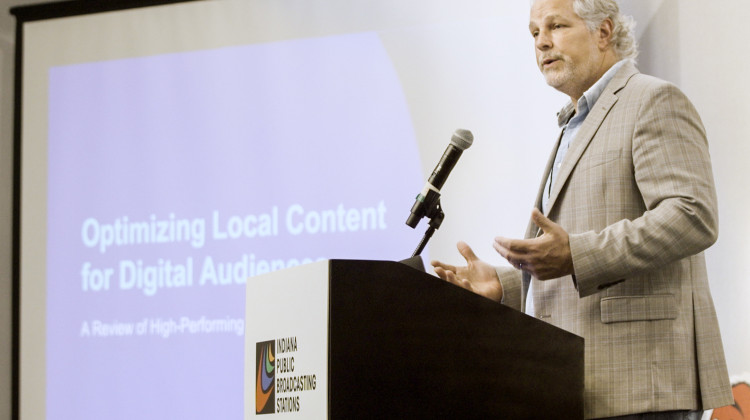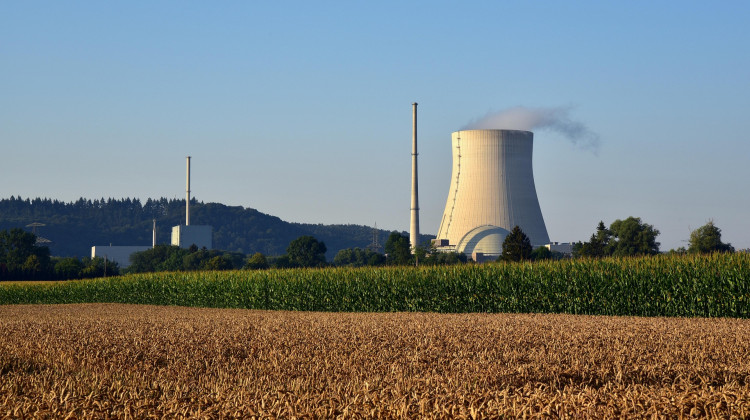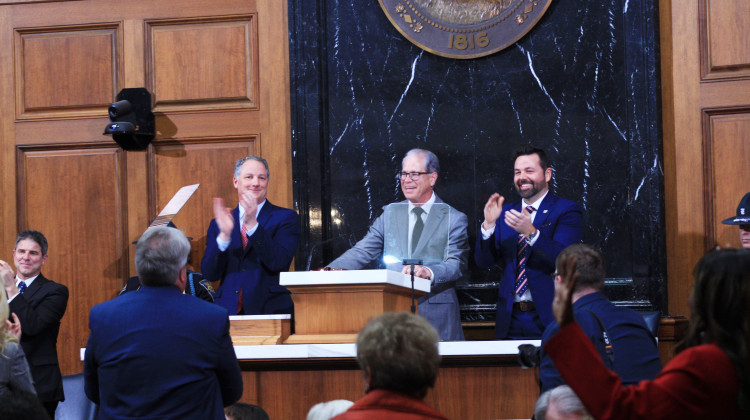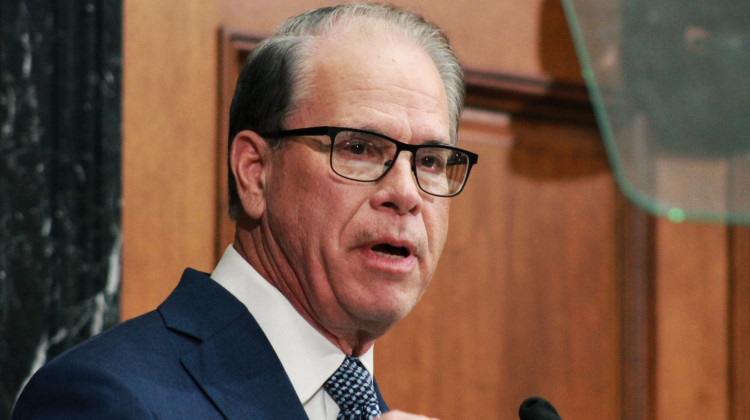
IPBS Executive Director Mark Newman kicks off the 2023 IPBS Conference. WNIN is part of the nine-member Indiana Public Broadcasting network.
Tim Jagielo / WNIN video stillWNIN’s Tim Jagielo sat down with the IPBS executive Director Mark Newman at the 2023 IPBS conference held Aug 1-2 at the Renaissance Hotel in Carmel, to talk about what IPBS can do for you, the listener.
Mark Newman: We’re in association of 17 television and radio stations, public media stations, all across Indiana. And it's my job to coordinate the activities of the association, help them generate funds, revenue resources in order for them to serve their public mandate, which is education, public safety, and civic engagement.
Timothy Jagielo: And there are and there are NPR affiliates, all the way from South Bend out Evansville. And so if you're driving through Indiana, and you hear one of these stations, are you hearing and IPBS station?
MN: So we have, we have nine radio stations and eight television stations across the state. And you're right, they stretch as far north as the South Bend Elkhart area, down to Evansville, and then sends so we really do cover a broad swath of the state, about 95-percent of Indiana households get an IPBS signal.
TJ: And how does it actually work as a cooperative organization?
MN: So these are all independently operated, community based television and radio stations. Now we have university licenses, and we have community licenses. But they're all localized. And they're operated at the local level. In some states, you'll find that they are a statewide network that is a network that may have some governmental affiliation. Actually, it could be an agency of state government, for example. But here, it's an association of independent public broadcasting stations that work together, as though they're a unit and do a great job of being supportive of one another and doing things that help to elevate public media in Indiana.

TJ: The demographics and basically everything are very different between the north and the south of the state. How have you seen where a stations located maybe influence the flavor of the coverage or the style?
MN: I think that's one of the beauties of the way that IPBS is organized, because it is an association of independent stations. They have the ability to cater to the needs of the viewing and listening audience that they serve. To your point in southern Indiana — It's a much different profile — If I could use that word or demographic, than what you would find in the northern part of state. I think we're under-credited for being a diverse state, and we actually have quite a bit of diversity across Indiana.
It just so happens that you have pockets where that diversity exists. And so what we do in public broadcasting is we look for ways to serve all of those different constituencies in an integrated way.
TJ: In 2023, how is the IPBS meeting the needs of the listeners or the viewers, and how can it be improved?
MN: Well, I think we're starting to fill the gap in a much more robust way that was previously held, or filled by local newspapers. As as local media has begun to leave markets or fall by the wayside, it's created a stronger value proposition and the platform for public media to step in, and really provide that localized news and information, those human interest stories, providing that content that really speaks to the community, whether it is travel related or nature related or science related, but really filling the need for the residents of our state who are who are pining for content that's relative to them, where they live, and how they live their lives.
TJ: What are some of the biggest challenges ahead? For IPBS for public media, in your view in Indiana?
MN: Because we're nonprofit news media, and nonprofit media in general, identifying funding sources, being able to maximize those sources rely upon them. That will continue to be one of the biggest challenges that we're confronted with. We pride ourselves on being a most trusted and reliable source for news and information as well. But as different factions attempt to call that into question, we're often put in a defensive posture, trying to explain what we are doing and how we are here to serve all Hoosiers and do it in this as fair and as balanced as we possibly can.
TJ: Do you think IPBS might have some areas of opportunity for serving those different demographics, and who they might be?
MN: Well, I think as you look to different segments within our broader population, whether it's an immigrant population and African American population, folks who are separated by different religious affiliations, we do have the ability, because of the nature of our storytelling to take deep dives into a particular area or subject area, and really explain those areas in some detail, to sort of raise consciousness and also to increase understanding. So at the end of the day, Hoosiers come to realize that we really are all in this together, working to achieve the same things for ourselves and our families, the people we care for. I think that's a big challenge that we're confronted with. But it's tremendous opportunity that I think we have as well.

TJ: I tend to think that NPR and maybe IPBS, too could do a better job of maybe challenging the stereotypical, maybe NPR listener and maybe try to include maybe the conservative voice a little bit more, or at least make sure that it's in the radar. Have you seen IPBS doing this? Do you think this is an area of opportunity?
MN: I do think it's an area of opportunity. I mean, if we're going to say that we're the ‘fair and balanced voice for all,’ we do have to offer both perspectives in a fair and balanced way and allow the consumer the opportunity to make a decision themselves about what they identify with or how they align their views or perspectives on a particular thing. That's important. I do think that that's our responsibility. And I think that's also what goes toward building trust among our listenership or viewership across the state.
TJ: What do you hope to see for the future of IPBS and for public media in general?
MN: Well, this conference that we're at this day and tomorrow, I mean, it really gives me some optimism because I see a great diversity of age of gender of ethnic background represented here, and they're all public media employees in Indiana. And as long as we have that going for us, I feel like being that representative voice, being able to express what Hoosiers are thinking, feeling and doing in their lives, I think we're on a good path there. And we need to continue attracting people into our industry that are representative of everyone, so that we can keep telling the stories of people in Indiana.
TJ: And just from your perspective, can you give me the elevator pitch for what the IPBS conference is and what you hope it achieves and how you hope it actually helps viewers and listeners and how it could benefit them, the stakeholders?
MN: Well, each of our stations are doing different things in different ways. And this conference is an opportunity to share best practices and new ideas and to establish relationships across our stations. You know, we were talking a minute ago about how we've got stations in Evansville, we've got stations in South Bend, Elkhart, Merrillville, I mean, across the state of Indiana. In a number of instances, we have people who here who have never met one another, they've never met a colleague from a different station, if those kinds of relationships can be nurtured. And if sharing of best practices and good practices takes place, then I think all our stations are better off in the end.
TJ: Is there anything you'd like to add about public media in the future? Anything you want to add about this conference?
MN: I think public media is here to stay — it serves too great of a function for it to fall by the wayside. But it's here because the people want it to be here. They allow it to be here. Ultimately, our mandate is to serve the public good. We are a public service media institution. And that's what we will continue to promote, and we will continue to push for because our success really is dependent on our ability to resonate with our listener and viewing audience.
 DONATE
DONATE






 Support WFYI. We can't do it without you.
Support WFYI. We can't do it without you.